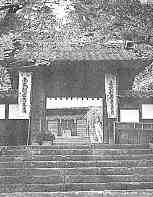The Salad Bowl. Vol. V, No. 3. Apr. 1997.
 Historic Sites in Shizuoka:
Historic Sites in Shizuoka:
Tesshuuji Temple

There are about sixty temples associated with the Rinzai school of Zen in
Shizuoka city. One temple with an interesting history
is Tesshuuji, known until recently as Kunouji.
According to legend, when Lord Hatakawa Katsu was hunting in the forests around Mt. Udo, he
discovered an image of the goddess Kannon in the trunk of a cedar tree. At that spot in
the year 586 A.D a temple was established. The first historic reference to this temple dates from 723 A.D.
when Lord Kunou built a temple according to imperial edict. In a way that parallels the
creation of national universities in Japan in the 1950s, Empress Suiko tried to establish
Buddhist learning centers all over the realm in the eighth century.
Although Tesshuuji was first associated with the Hossou sect of Buddhism, it changed affiliation
four times in the course of history. During the Kamakura era it was one of the leading temples
of the Tokaido area and Minamoto Mitsuyuki made a pilgrimage here in 1223 A.D.
His flute is among the temple's treasures.
After Takeda Shingen conquered the Imagawa clan in 1573, he relocated the temple a
kilometer east to a less strategic position, building a defensive castle on the former temple precincts.
Tokugawa Ieyasu, who visited this temple as a youth, offered his patronage and even today the
temple roof tiles bear his family crest.
With the onset of the Meiji Restoration, animosity to "foreign" Buddhist teachings surfaced along with
desire to restore "pure Japanese" Shinto principles. Since the shogunate required all citizens to be registered at a temple
and some temples taxed the populace heavily, it is not surprising that some peasants felt contempt for wealthy temples. Tesshuuji
Temple experienced a loss of revenue and patronage at the onset of the Meiji Era.
In 1854 much of the temple was destroyed by a large earthquake and it was not until 1883 that
Yamaoka Tesshuu, a noted politician, provided the funds for its repairs. Jiro-cho, the "godfather" of Shimizu (now part
of Shizuoka), also made sure ample funds were available. His statue rests within the temple precincts. The contributions of
Shibano Eihiji, a wealthy merchant, were also significant. Although Yamaoka Tesshuu did not live to see the full
restoration of this temple, the temple was named in his honor and rebuilt by 1901.
During WW II a garrison of soldiers was stationed here and the temple was fortunate to escape the bombing which devastated
much of this city towards the end of the war. Today Tesshuuji has about 300 family parishioners and Koumura Toshiaki, now 64,
is the 4th generation Rinzai master (juushoku) of this temple.
Tesshuuji has a number of splendid treasures, including a ceremonial robe worn by Emperor Meiji,
a painting by Miyamoto Mushashi, and writing by Kobo Daiyashi.
Most of these are only displayed on special occasions. Ordinary visitors can enjoy Tesshuuji's splendid
view of Shizuoka city anytime and, on sunny days, also see Mt. Fuji and the Izu peninsula from the temple precincts.
Tesshuuji is open from 9:00 AM to 5:00 PM and located about 15 minutes northeast of Shimizu JR Station by bus on Route 150,
in Muramatsu. Admission is 300 yen.
- Tim Newfields

www.tnewfields.info/sb/tes.htm
copyright 1998 by Tim Newfields and the Shizuoka City International Association
(The author thanks Morita Takashi and Imizu Gyoubun for their help with this article)
 Historic Sites in Shizuoka:
Historic Sites in Shizuoka: